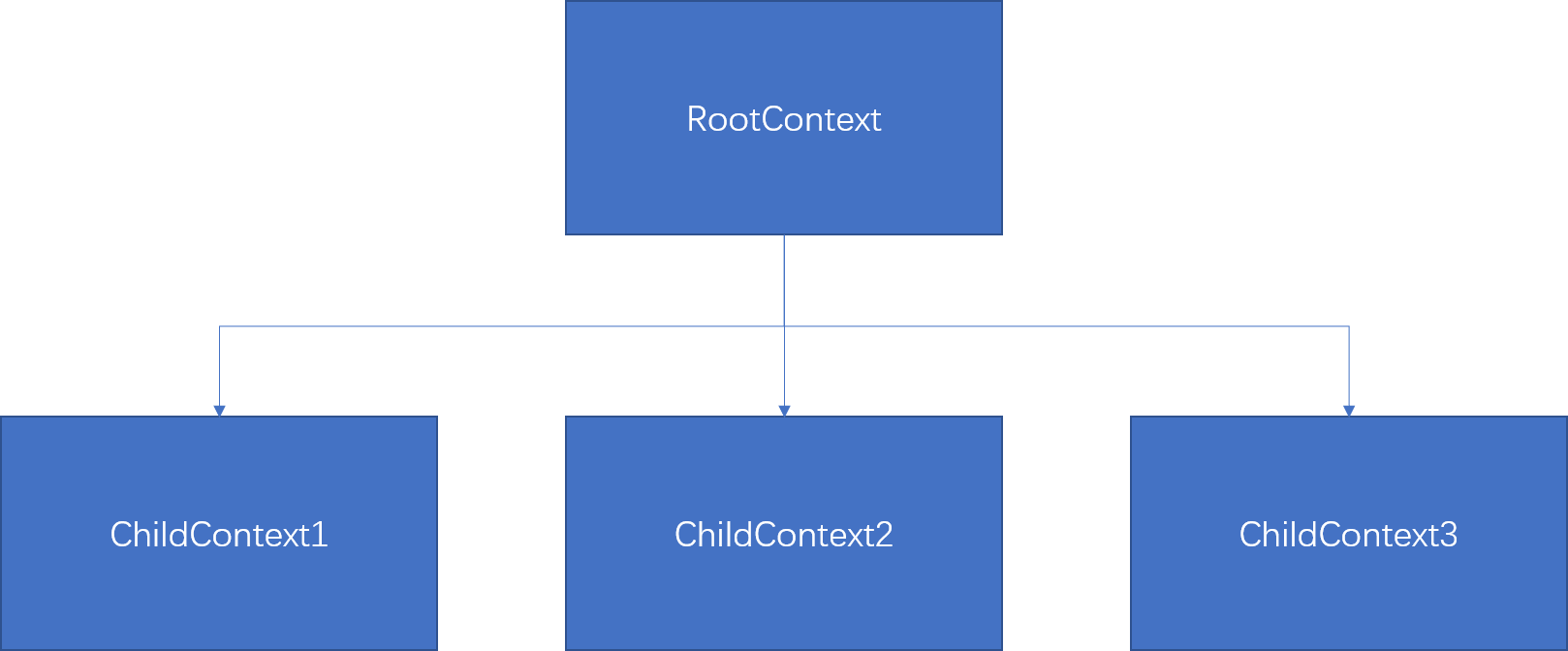ApplicationContext 是 spring 用来容纳管理 beans 以及其生命周期的容器。ApplicationContext 的分层规定了bean的界限以及可以复用的 bean。关于 ApplicationContext 层级可以参考官方文档(http://docs.spring.io/spring-boot/docs/current/reference/htmlsingle/#howto-build-an-application-context-hierarchy),这里我们通过一个简单的例子来说明下 ApplicationContext 层级以及其中的bean界限,例如某些 bean 可以被多个 ApplicationContext 共享,同时某些 bean 只在某个 ApplicationContext 生效,不同 ApplicationContext 可以声明同名或者同类型的bean这样。我们将实现一个下图所示的 ApplicationContext 结构:

我们会实现,一个 parent context 与三个对应 child context 的结构。
首先定义Parent context:
Bean类:
package com.test.spring.context.bean;
import lombok.Data;
import lombok.NoArgsConstructor;
@Data
@NoArgsConstructor
public class RootBean {
private Stirng name;
}
Context类:
import com.hopegaming.scaffold.spring.context.bean.RootBean;
import org.springframework.context.annotation.Bean;
import org.springframework.context.annotation.Configuration;
@Configuration
@PropertySource(value = "classpath:/root.yaml", factory = YamlPropertyLoaderFactory.class)
public class RootContext {
@Bean
public RootBean getFatherBean() {
RootBean rootBean = new RootBean();
rootBean.setName("root");
return rootBean;
}
}
root.yml:
# 配置这些主要是将actuator相关接口暴露出来。
management:
endpoint:
health:
show-details: always
endpoints:
jmx:
exposure:
exclude: '*'
web:
exposure:
include: '*'
由于我们使用了yml,这里需要我们自定义一个YamlPropertyLoaderFactory用于加载yml配置:
package com.test.spring.context.config;
import org.springframework.boot.env.YamlPropertySourceLoader;
import org.springframework.core.env.PropertySource;
import org.springframework.core.io.support.DefaultPropertySourceFactory;
import org.springframework.core.io.support.EncodedResource;
import java.io.IOException;
public class YamlPropertyLoaderFactory extends DefaultPropertySourceFactory {
@Override
public PropertySource<?> createPropertySource(String name, EncodedResource resource) throws IOException {
if (resource == null){
return super.createPropertySource(name, resource);
}
return new YamlPropertySourceLoader().load(resource.getResource().getFilename(), resource.getResource()).get(0);
}
}
定义child context的公共Bean类:
package com.test.spring.context.bean;
import lombok.Data;
import lombok.NoArgsConstructor;
@Data
@NoArgsConstructor
public class ChildBean {
private RootBean fatherBean;
private String name;
}
定义ChildContext1:
package com.test.spring.context.config.child1;
import com.hopegaming.scaffold.spring.context.bean.ChildBean;
import com.hopegaming.scaffold.spring.context.bean.RootBean;
import com.hopegaming.scaffold.spring.context.config.YamlPropertyLoaderFactory;
import org.springframework.beans.factory.annotation.Value;
import org.springframework.boot.autoconfigure.SpringBootApplication;
import org.springframework.context.annotation.Bean;
import org.springframework.context.annotation.PropertySource;
@SpringBootApplication(scanBasePackages = {"com.test.spring.context.controller"})
@PropertySource(value = "classpath:/bean-config-1.yaml", factory = YamlPropertyLoaderFactory.class)
public class ChildContext1 {
@Bean
public ChildBean getChildBean(@Value("${spring.application.name}") String name, RootBean fatherBean) {
ChildBean childBean = new ChildBean();
childBean.setFatherBean(fatherBean);
childBean.setName(name);
return childBean;
}
}
bean-config-1.yaml:
server:
port: 8080
spring:
application:
name: child1
接下来分别是ChildContext2,ChildContext3的:
package com.test.spring.context.config.child2;
import com.hopegaming.scaffold.spring.context.bean.ChildBean;
import com.hopegaming.scaffold.spring.context.bean.RootBean;
import com.hopegaming.scaffold.spring.context.config.YamlPropertyLoaderFactory;
import org.springframework.beans.factory.annotation.Value;
import org.springframework.boot.autoconfigure.SpringBootApplication;
import org.springframework.context.annotation.Bean;
import org.springframework.context.annotation.PropertySource;
@SpringBootApplication(scanBasePackages = {"com.test.spring.context.controller"})
@PropertySource(value = "classpath:/bean-config-2.yaml", factory = YamlPropertyLoaderFactory.class)
public class ChildContext2 {
@Bean
public ChildBean getChildBean(@Value("${spring.application.name}") String name, RootBean fatherBean) {
ChildBean childBean = new ChildBean();
childBean.setFatherBean(fatherBean);
childBean.setName(name);
return childBean;
}
}
server:
port: 8081
spring:
application:
name: child2
management:
endpoint:
health:
show-details: always
endpoints:
jmx:
exposure:
exclude: '*'
web:
exposure:
include: '*'
package com.test.spring.context.config.child3;
import com.hopegaming.scaffold.spring.context.bean.ChildBean;
import com.hopegaming.scaffold.spring.context.bean.RootBean;
import com.hopegaming.scaffold.spring.context.config.YamlPropertyLoaderFactory;
import org.springframework.beans.factory.annotation.Value;
import org.springframework.boot.autoconfigure.SpringBootApplication;
import org.springframework.context.annotation.Bean;
import org.springframework.context.annotation.PropertySource;
@SpringBootApplication(scanBasePackages = {"com.test.spring.context.controller"})
@PropertySource(value = "classpath:/bean-config-3.yaml", factory = YamlPropertyLoaderFactory.class)
public class ChildContext3 {
@Bean
public ChildBean getChildBean(@Value("${spring.application.name}") String name, RootBean fatherBean) {
ChildBean childBean = new ChildBean();
childBean.setFatherBean(fatherBean);
childBean.setName(name);
return childBean;
}
}
server:
port: 8082
spring:
application:
name: child3
management:
endpoint:
health:
show-details: always
endpoints:
jmx:
exposure:
exclude: '*'
web:
exposure:
include: '*'
测试接口TestController:
package com.test.spring.context.controller;
import org.springframework.beans.factory.annotation.Autowired;
import org.springframework.beans.factory.annotation.Value;
import org.springframework.web.bind.annotation.RequestMapping;
import org.springframework.web.bind.annotation.RestController;
import java.util.Locale;
@RestController
public class TestController {
@Autowired
private ChildBean childBean;
@RequestMapping("/test")
public ChildBean getChildBean() {
return childBean;
}
}
启动类:
package com.test.spring.context;
import com.hopegaming.scaffold.spring.context.config.child1.ChildContext1;
import com.hopegaming.scaffold.spring.context.config.child2.ChildContext2;
import com.hopegaming.scaffold.spring.context.config.child3.ChildContext3;
import com.hopegaming.scaffold.spring.context.config.root.RootContext;
import org.springframework.boot.builder.SpringApplicationBuilder;
import org.springframework.context.ConfigurableApplicationContext;
public class ContextMain {
public static void main(String[] args) {
SpringApplicationBuilder appBuilder =
new SpringApplicationBuilder()
.sources(RootContext.class)
//第一个子context用child,剩下的都用sibling
.child(ChildContext1.class)
.sibling(ChildContext2.class)
.sibling(ChildContext3.class);
ConfigurableApplicationContext applicationContext = appBuilder.run();
}
}
启动后,访问http://127.0.0.1:8080/test返回:
{"fatherBean":{"name":"root"},"name":"child1"}
访问http://127.0.0.1:8081/test返回:
{"fatherBean":{"name":"root"},"name":"child2"}
访问http://127.0.0.1:8082/test返回:
{"fatherBean":{"name":"root"},"name":"child3"}
访问http://127.0.0.1:8080/actuator/beans会有类似于下面的返回(省略了不关心的bean):
{
"contexts": {
"application-1": {
"beans": {
"getChildBean": {
"aliases": [],
"scope": "singleton",
"type": "com.hopegaming.scaffold.spring.context.bean.ChildBean",
"resource": "com.hopegaming.scaffold.spring.context.config.child2.ChildContext2",
"dependencies": [
"getFatherBean"
]
},
"childContext2": {
"aliases": [],
"scope": "singleton",
"type": "com.hopegaming.scaffold.spring.context.config.child2.ChildContext2$$EnhancerBySpringCGLIB$$26f80b15",
"resource": null,
"dependencies": []
}
.......
},
"parentId": "application"
},
"application": {
"beans": {
"getFatherBean": {
"aliases": [],
"scope": "singleton",
"type": "com.hopegaming.scaffold.spring.context.bean.RootBean",
"resource": "com.hopegaming.scaffold.spring.context.config.root.RootContext",
"dependencies": []
},
"rootContext": {
"aliases": [],
"scope": "singleton",
"type": "com.hopegaming.scaffold.spring.context.config.root.RootContext$$EnhancerBySpringCGLIB$$18d9c26f",
"resource": null,
"dependencies": []
}
.......
},
"parentId": null
}
}
}
通过这个例子,想必大家对于 ApplicationContext 层级有了一定的理解
每日一刷,轻松提升技术,斩获各种offer:






















 382
382











 被折叠的 条评论
为什么被折叠?
被折叠的 条评论
为什么被折叠?








